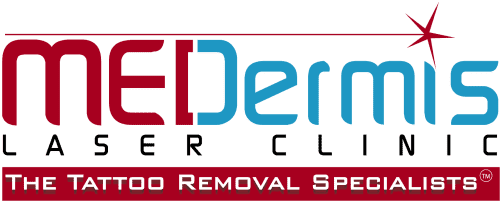Spectra Pico Plus Laser Tattoo Removal System
Tattoo Removal Technology
Since being founded in 2006, MEDermis has made a commitment to using the absolute best in tattoo removal technology. Right now, the best is the Spectra Pico Plus laser system by Lutronic.
Our team has significant experience using other laser systems (the Hoya Conbio laser, Cynosure Revlite laser, and Picosure laser), but the Spectra laser system has proven superior by reducing the number of sessions needed and minimizing discomfort to clients. We found the total number of sessions reduced by almost 30 percent when using the Spectra Pico Plus laser and stubborn green and blue ink colors responded just as well as any other color. We consider the Spectra Pico laser system to be the Gold Standard in tattoo removal lasers.
Early Tattoo Removal Methods and Technology
Did you know that tattoo removal is almost as old as tattoos themselves? Tattoos could have a variety of meanings in ancient culture, including use for religious ceremonies, rites of passage and marking one’s social status. Removal methods included a primitive form of dermabrasion — scraping the skin with a rough material like sandpaper until no more ink appeared on the surface.
Other forms of early tattoo removal included excision, dermabrasion, scarification and surgical removal. Modern attempts of laser removal started in the 1960s by Leon Goldman. He developed a laser that used hot vapor bursts that left the skin charred. In the 1980s, Rox Anderson created an alternative laser that removed a tattoo and left a scar. But this laser only worked three-quarters of the time and could take nearly two years to complete the job. Now, we use Nd: YAG Q-switched lasers as the best tattoo removal method. These lasers are the most proven and effective in removing unwanted ink without damaging the skin.
MEDermis Laser Clinic Uses Only the Best: Spectra Pico Plus Laser System by Lutronic
The Spectra Pico system laser technology offers versatility, built-in-safety, and enhances clinical outcomes making it a superior tool in tattoo removal.
The Spectra Pico laser delivers light at incredibly high energy for a tiny fraction of a second onto the skin. This breaks up large tattoo pigments, which are then removed over time by your body’s natural healing processes.
Light and heat from Spectra’s wavelengths are only absorbed into the target areas, minimizing damage to the tissue surrounding the unwanted tattoo ink. Tattoo removal treatments are more efficient and less damaging to the skin.
The Spectra Pico has four different wavelengths allowing our Certified Laser Specialists to target and control the intensity level of the beam. This versatility translates to minimal thermal damage to the skin, while still effectively removing even the most stubborn tattoo inks. Learn more about the Spectra Laser System.
How Successful Is Laser Tattoo Removal?
Laser tattoo removal is considered the most successful form of removing your old and unwanted ink, but there are several variables that can affect your success rate:
- Ink color: Typically, blue and black inks are easier to remove while oranges, yellows and whites are more challenging.
- Tattoo age: Older tattoos are easier for professionals to remove because the concentration and density of the ink are lower than in a newer tattoo.
- Smoking: Smoking can affect the healing of wounds. A 2010 study by the Journal of the American Medical Association found subjects who smoked had a 70 percent lower rate of removal after 10 sessions.
- Skin color: Tattoo removal is more effective in people with lighter skin because the lighter skin doesn’t significantly absorb laser light, so the laser is more concentrated on the tattoo pigment. Darker skin absorbs a portion of the light. Also, most professionals will use lower machine settings to prevent side effects on darker skin.
- Location: Areas of the body with lower circulation, like the feet, lower legs, hands and face will take longer to heal, and removal will be slower.
- Amount of ink: Professionals use a higher density and volume of ink and have deeper penetration into the skin. Amateur tattoos, however, use less ink and are more superficial, therefore easier to remove.
- Layered tattoos: Tattoos that have been covered by a newer piece can be difficult to remove because the artist had to use darker tones to layer, and the area is now larger to cover the original. Coverups also require a higher volume and density of ink to cover the previous tattoo.
While all of these factors can affect how well your tattoo is removed, at MEDermis Laser Clinic, we’re proud to have a 95-98 percent ink clearance and achieve results without damaging your skin.
Is Laser Removal Safe?
Of the varying forms of tattoo removal, using a laser is today considered the best and safest form of tattoo removal. Laser removal technology uses a laser to break the ink in your skin into smaller particles that your body will naturally eliminate through the blood stream.
Unlike older methods like dermabrasion or surgical removal, a laser will remove the colors of your tattoo with little to no scarring or other uncomfortable side effects like bleeding, swelling, infection or permanent scarring.
Trust the Professionals at MEDermis Laser Clinic
Since 2006, MEDermis Laser Clinic has been the most trusted laser removal professionals in the San Antonio and Austin, TX areas. We offer all of our clients a free consultation to determine the number of sessions needed and answer any questions.
At MEDermis we were one of the first companies to offer a guarantee — if we give an estimate and you require more sessions to remove your undesirable ink, we’ll continue treating the area at no additional charge to you for up to one year. Complete our online consultation request form today or call us at our San Antonio office at 210-402-4030 or our Austin location at 512-637-5277 to speak with a removal specialist.
